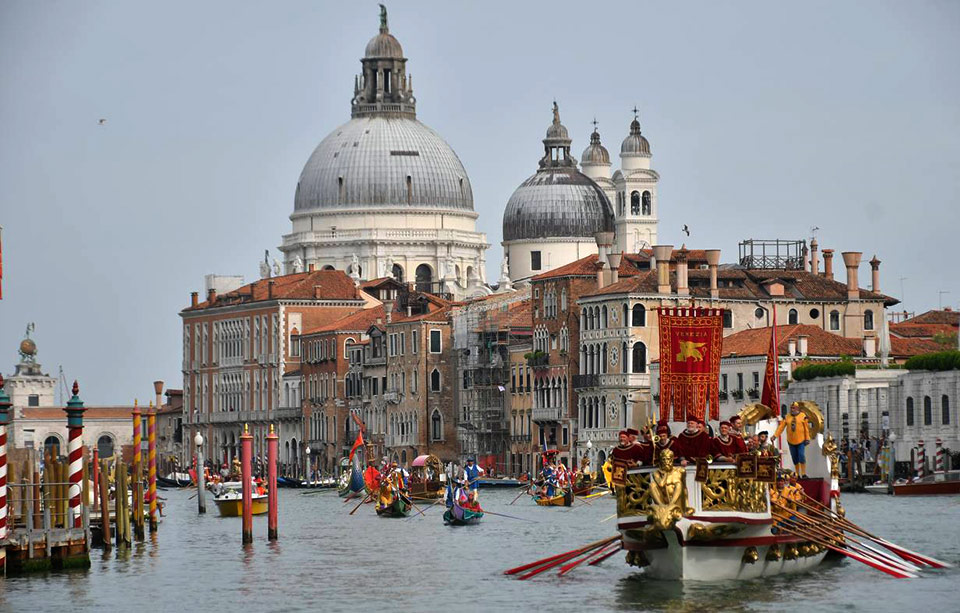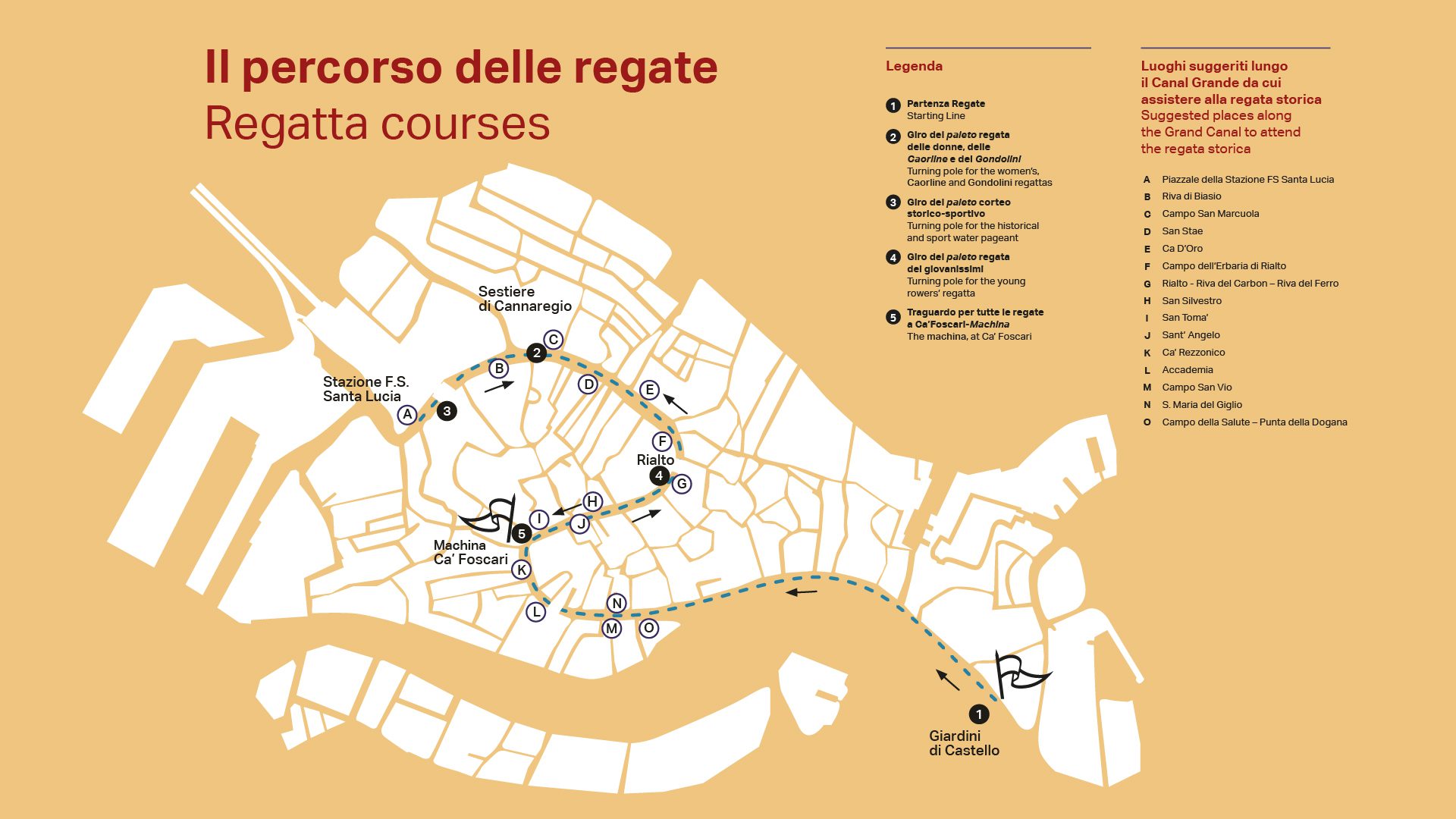The Regata Storica is the main event in the annual "Voga alla Veneta" calendar. This unique sport has been practised in the Venetian lagoon for thousands of years and today it is well-known for the spectacular historical water pageant that precedes the race.
Scores of typically 16th century-style boats with gondoliers in period costume carry the Doge, the Doge's wife and all the highest ranking Venetian officials up the Grand Canal in a brightly coloured parade. An unforgettable sight and a true reconstruction of the glorious past of one of most the powerful and influential Maritime Republics in the Mediterranean.
In the Regata Storica there are four races divided in terms of age and type of craft. The best known and most exciting of these is the "Campioni su Gondolini" race, where a series of small, sporting gondolas fly down the Grand Canal to the finishing line at the famous "machina", the spectacular floating stage located in front of the Ca' Foscari palace.






Water is the element that most characterises Venice and it is no coincidence that the most famous and spectacular festivity in the city takes place on the waters of the Canal Grande. The spectacular event starts with a magnificent historical procession consisting of splendid, elaborately carved boats complete with hundreds od figures in gorgeous brocade costumes.
Even now the Regata Storica is one of the most spectacular, picturesque and moving events of Venetian life, capable of both charming the tourists and exciting the locals. A historical procession commemorates the welcome given to Caterina Cornaro, wife of the King of Cyprus, in 1489 after she renounced her throne in favour of Venice. It is a procession of 16th century style boats, with the famous Bucintoro, the boat representing the Serenissima, at its head.
Many different competitions take place within the Regata Storica: the champions regatta in "gondolini", the regatta in "caorline", the women's regatta in "mascarete", the young rowers' regatta in "pupparini". And many different types of boats take part in the Regata Storica: the "gondolino", the "caorlina", the "mascareta", the "pupparin", and, of course, the gondola, the Venetian boat par excellence.
Venice Historical Regatta Program
The Historical Regatta takes place every year on the first Sunday of September. The next edition will take place on Sunday 1 September 2024. This race is divided into two phases: the Historical Parade and the Competitive Regattas.
Thursday before
Presentation of the teams and blessing of the Gondolini in Campo della Salute (6.00 pm).
Sunday of the Regatta
- 4.00 pm Historical and sport water pageant: parade along the Grand Canal by historical crafts with costumed crews, boats and gondolas of the Venetian rowing associations (Voga alla Veneta). Course: from St. Mark's Bay all the way down the Grand Canal.
- 5.00 pm Young Rowers twin-oared pupparini regatta. Course: the Castello Gardens, St. Mark's Bay, Grand Canal, Rialto (around the paleto in front of the Banca d'Italia), and back to finish at Ca' Foscari.
- 5.20 pm Women's twin-oared mascarete regatta. Course: the Castello Gardens, St. Mark's Bay, Grand Canal, Rialto (around the paleto in front of the Banca d'Italia), and back to finish at Ca' Foscari.
- 5.50 pm Six-oared caorline regatta. Course: the Castello Gardens, St. Mark's Bay, Grand Canal, Rialto (around the paleto in front of the Santa Lucia railway station), and back down the Grand Canal to finish at Ca' Foscari.
- 6.10 pm, after the passage of caorline (match for third place) and 6.40 pm, after the passage of gondolini (final) Universities Boat Challenge: challenge on eight-oared galeoni boat by the crew of the Ca' Foscari and Iuav Universities of Venezia versus other Italian and foreign Universities. Course: From Rialto to Ca'Foscari.
- 6.20 pm Twin-oared gondolini regatta. Course: the Castello Gardens, St. Mark's Bay, Grand Canal, Rialto (around the paleto in front of the Santa Lucia railway station), and back down the Grand Canal to finish at Ca'Foscari.
Where to attend the Regata Storica
Suggested places along the Grand Canal to attend the Regata Storica:
- Piazzale della Stazione FS Santa Lucia
- Riva di Biasio
- Campo San Marcuola
- San Stae
- Ca D'Oro
- Campo dell'Erbaria di Rialto
- Rialto. Riva del Carbon. Riva del Ferro
- San Silvestro
- San Tomà
- Sant'Angelo
- Ca' Rezzonico
- Accademia
- Campo San Vio
- S. Maria del Giglio
- Campo della Salute. Punta della Dogana.
Map of places along the Grand Canal to attend the Regata Storica:
History
The regata has always been extremely popular with both Venetians and visitors. The first historical record of the event dates back to the mid 13th century, when it was part of the “Festa delle Marie” celebrations. However, it is likely that regattas existed long before this, as Venice has always been a seafaring city and training reserves of oarsmen was a prime necessity. The first visual image of a regatta comes somewhat later, in the View of Venice drawn by Jacopo dé Barbari in around 1500. This map includes a detail of a group of boats with the word “regata” written at the side. From there onwards the regatta became a favourite subject with scene painters wishing to capture the festive spirit of the city. The etymology of the word is uncertain, but it probably derives from aurigare, a verb used in the 16th century as a synonym for racing, and since then the term has come to mean a boat race in all the main European languages. Originally regattas were either races between boatmen and gondoliers or regate grandi (organized for special religious or civic occasions).
In time, financing the regattas shifted from the Republic to private individuals, who were often foreign princes. In 1797, when the Republic officially ceased to exist, the regattas certainly did not, and in that same year, the city’s democratic government announced two races for its citizens. The modern regata dates back to 1841, when the organizational expenses moved back from the private to the public sphere. In that year, the Municipality of Venice requested the Austrian authorities to proclaim an annual “boat race along the Grand Canal, organized by the local authorities to encourage gondoliers to uphold the honour of their famed skills”. In 1866 when Venice became part of the Kingdom of Italy, the focus of the event changed, and instead of just a race, the regattas became a celebration of the glorious history of the Republic of Venice. Despite this, it was not until 1899, the year of the 3rd International Biennale Art Exhibition, that this was officially recognised by Count Filippo Grimani, Mayor of Venice, who coined the name, “Regata Storica”.
Race Awards
The top 4 teams receive, in addition to cash prizes, traditional flags of different colors: red for the winners, white for second place, green for third and blue for fourth place. But the greatest prize is undoubtedly the fame and glory that accompany the winners for an entire year during which they are admired by all the sailors of the Venice Lagoon.


